This week Mr Slang takes us back to 19th Century America and a remarkable ‘Chronicle of the Turf, Agriculture, Field Sports, Literature, and the Stage’…
‘I’m a Salt River Roarer! I’m a ring-tailed squealer! I’m a reg’lar screamer from the ol’ Massassip’! WHOOP! I’m the very infant that refused his milk before its eyes were open, and called out for a bottle of old Rye! I love the women an’ I’m chockful o’ fight! I’m half wild horse and half cockeyed-alligator and the rest o’ me is crooked snags an’ red hot snappin’ turtle. I can hit like fourth-proof lightnin’ an’ every lick I make in the woods lets in an acre o’ sunshine. I can out-run, out-jump, out-shoot, out-brag, out-drink, an’ out fight, rough-an’-tumble, no holts barred, any man on both sides the river from Pittsburg to New Orleans an’ back again to St. Louiee. Come on, you flatters, you bargers, you milk-white mechanics, an’ see how tough I am to chaw! I ain’t had a fight for two days an’ I’m spilein’ for exercise. Cock-a-doodle-doo!’
America’s propensity for larger-than-life heroes is well established. As a words man rather than action man I find them charmless and suspect that they erred to the monosyllabic, but I am but a stunted scion of Old Europe and when nostalgics call for better days, those days when ‘when men were men’, these were the men of whom they sing. I do not mock but I do wonder, in every sense.
In my childhood we had Davy Crockett, who like all things exciting came from the States, albeit a century previous, and whose surviving pictures show him as a centre-parted, somewhat dandified senator. This was not the image we sought: our man, and it had to be true since it was enshrined on TV, had a coonskin cap and like many of his kin and when still in short pants, had ‘killed him a bar’. The supply of ‘bars’ was presumably not inexhaustible, though they seem to have survived better than their hunters. The frontiersman has gone, as has the frontier, but at least it was there. Little England could never boast such vastness, nor the exploits that it seemed to conjure forth.
Nor could every growing American claim his own bar. It was simpler to encounter him and his pursuers in print. The primum inter pares of such publications was The Spirit of the Times, further subtitled ‘A Chronicle of the Turf, Agriculture, Field Sports, Literature, and the Stage’ was founded to play a similar role to its London contemporary Bell’s Life in London and to Bell’s successor the Sporting Times. Launched in 1831 by the ex-printer William T. Porter, it was soon established as the leading chronicler of American sport, which meant horse-racing and after that prize-fighting. But Porter’s use of amateur correspondents – since the modern sporting writer had yet to emerge – many of whom lived far from New York, meant that the Spirit became a repository for a wide range of non-standard usages, especially those of the South and West.
Among the terms that the Spirit coined was the bear story, otherwise known as a tall tale. And many of these literally outlandish words were first used by what has been termed the ‘Big Bear’ school of humourists. These included such backwoods anecdotalists as W.C. Hall (author of various tales of ‘Mike Hooter’, usually found tussling with the inevitable ‘Bar’ although equally ready to deal with a panther), George Washington Harris (author among much else of the interestingly titled ‘Knob Dance — a Tennessee Frolic’) perhaps the most talented of the team, and one who would leave the Spirit to pursue his own backwoods character ‘Sut Lovingood’. Not all the contributors were southerners: Francis A. Durivage and George P. Burnham, who co-wrote Stray Subjects Arrested and Bound Over (1846) were Yankees. Anthologies of Spirit sketches came out regularly, the first A Quarter Race in Kentucky in 1846, shortly followed by a successor The Big Bear of Arkansas.
The writers themselves may have been relatively well-off, but their back-country homes were far from the sophisticated east. The stars of their stories, whose real-life equivalents they would have known, were the white trash in embryo that Porter’s biographer Norris Yates has termed ‘one-gallus whites’; they enjoyed hard liquor, practical joking, hunting and rough-housing, with a good deal of bawdy, if unspecified, sex on the side. The hero slaughters anything that moves, downs another jug or two, beats up anyone within reach (usually with much eye-gouging, lip-tearing and knife-work) and calls for more. Their aggressive racism, whether towards Indians or ‘niggers’, is a given. And it was all, at least as presented in the Spirit, one big laugh.
None more so than the riverboatman and trapper Mike Fink, ‘the King of the Keelmen’, known from his youth as ‘Bang-all’ from the carnage he wreaked on a wide spectrum of animal victims. But why stop at animals? Fink professed a number of what even admirers termed ‘queer ways’ – typically involving random potshots at passers-by, the shooting of full cans of whiskey from the heads of his intimates and the beating unconscious of those who failed to laugh at his jokes – that would in our softer times be termed dangerously psychotic. By all accounts – there are many – Fink was best left alone, and indeed lived with what sounds suspiciously like a teenage catamite, in a cave. He was equally fond of a long list of what chroniclers term ‘chère amies’ (two legs presumably good even if four legs less so). Like Crockett he would fall in time to Disneyfication but real life tells of an increased appetite for drinking the whisky as well as puncturing its container. He ended shot dead in contentious circumstances, victim of an erstwhile friend who resented Mike’s perhaps understandable inability to hit the whiskey every time, and therefore his unfortunate (some claimed deliberate) killing of that same young companion. It was Fink who offered the self-analysis printed above. One might not liked very much to have met him, but the hat must be tipped.

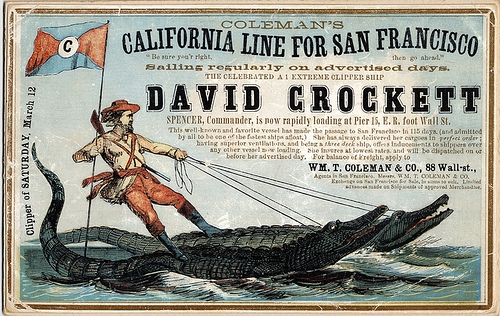

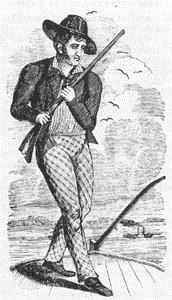

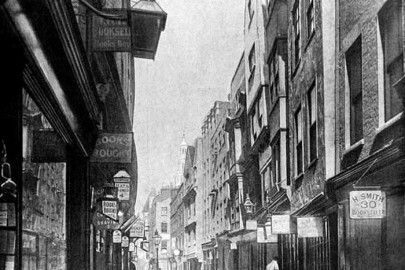
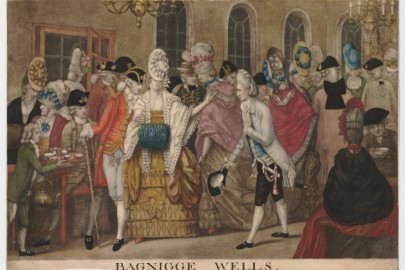
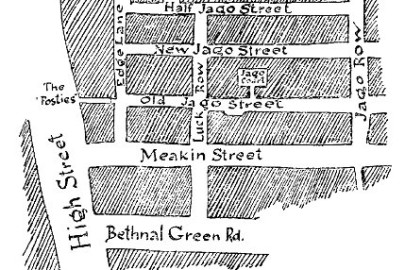







obvious question but it had to be asked – is this fink the originator of ‘fink’ as a derogatory term?
Heaven forfend!
GDoS says: ety. unknown; although the American Mercury (Jan. 1926) claimed that ‘dating from the famous Homestead strike of 1892 is the odious fink. [It] according to one version was originally Pink, a contraction of Pinkerton, and referred to the army of strike-breakers recruited by the detective agency’; that popular ety. is considered to be most likely spurious, since no citations of fink = strikebreaker have been found prior to 1914; for an alternative theory note Hist. Dict. Amer. Sl: ‘G[erman] Fink “student not belonging to the students association […] hence, not one of the guys”; […] or G. Schmierfink “a low dirty hack”.’
In other words: ety. unknown.
‘Come on, you flatters, you bargers, you milk-white mechanics, an’ see how tough I am to chaw! I ain’t had a fight for two days an’ I’m spilein’ for exercise. Cock-a-doodle-doo!’ (The preface to George Osborne’s budget speech: House of Commons, Wednesday, 20th March, 2013). If only Hansard had recorded it like that, the Member for Tatton would have had my vote for life. As it is, he didn’t and he won’t……
If legend has somewhat gilded Mike Fink’s lily (and I’m not telling his descendents, unless someone’s prepared to cover my hospital bills), he was clearly still one heck of a bloke. How did they get him before a court? A posse of 30 men with ropes, nets and shackles? It must have been nerve-shredding knocking on his cave door and asking him to come quietly. Was he bisexual with an added penchant for raccoon?
It seems, Jonathon, that keelmen were a breed apart. I’ve been reading about those who worked on the Tyne and Wear transporting coal to ships in deep water. They were very aggressive, hard drinkers, and without fear of the consequences of taking strike action. In times of war the Royal Navy viewed them as fair game for impressment. In 1803, fifty three were captured. Their wives armed with rolling pins, shovels and pans, marched to North Shields to rescue the men, while fellow keelmen went on strike in support. A compromise was reached: one in ten of Tyne keelmen ‘volunteered’ for the navy; the remainder were exempted from impressment. Mike Fink (“Eeeh man, ahm gannin te the booza”) would have loved it – punch-ups galore!
I remember Fess Parker as Davy Crockett – soft spoken, but carrying a big stick. Coonskin caps, or more precisely their affordable equivalents, were everywhere; moggies had to do. It must have taken twenty years for the cat population to recover.
Here’s the musical accompaniment John, my mother Kathleen used to sing it to me in an attempt to induce sleep, failing that she handed me over to my grandmother. She could sing, not as well as the heavenly Kathleen Ferrier however. Sandgate, mentioned in the song, still exists today, complete with modern hotel and trendy restaurants, lunchtime haunt for the legal operatives who now inhabit the quayside. The Keelmen were tribal and tended to form settlements as did the later lighter boatmen and river pilots, most of whom lived on the Law Top at South Shields. The descendants of the watery workers made excellent crew members aboard the Norwegian Whalers that berthed in the Tyne during the nineteen fifties, the most famous of these was the Magadan, the factory ship, could smell it six hours before it arrived, giving early warning to the hookers who serviced the crew.
Back to the cowboys and their place in the cultural upbringing of British knaben during the forties and fifties, I had this stylised, idealised vision of the west, Marion Mitchell Morrison aka Wayne, Walter Brennan, Tom Mix, Roy Rodgers and the unforgettable Jack Elam, goodies in buckskin, baddies in black. Then I read Caro’s marathon three parter, the biography of LBJ, the first volume covers the early days in East Texas, no more cowies riding off into the golden sunset.
Used to have a Davy Crockett hat, not as useful as the Tom Mix set however, this came complete with a Colt 45.
Unfortunately the horse was extra.
Thanks for the background, Malty. I’ve loved folk song since I was quite young, and Kathleen Ferrier’s version of the Keel Row is wonderful. I first came across Ferrier through Blow the Wind Southerly. I thought: ‘Blimey! Is it a bloke? Sounds 100 years old.’ She was 37. It was only when I gained a few years and a little sense that I realised she was one of the great singers. When I think of North East folk song, Blaydon Races comes to mind, the singing of which was often the highlight of cup finals involving Newcastle United. On those rare occasions, I became a Geordie for a day, and all because of that song.
Mike Fink was still working on the rivers at the time of his death at 53. I wonder if that was an age when your average keelman had long since bitten the dust through exhaustion or injury? There was nothing average about Fink. Until today, I’d not heard of him; now I’m fascinated by him.
I too am a child of the 50’s, who wore an official Davy Crockett coonskin hat while hunting beer cans and Coke bottles with a pellet gun during long summer days on my grandfather’s cattle ranch.
Several years ago, while driving through the hill country north of Santa Barbara, California, I chanced upon an establishment whose name caused profound cognitive dissonance: The Fess Parker Winery. Hoping to find shelves sagging with jugs of barely drinkable hooch made from backwoods fruit like chokecherry or paw-paw, I hastened inside, finding instead a rustic-chic tasting room festooned with plaques awarded at international wine competitions and with photographs of a plumpish, silver-haired Davy Crockett holding a glass of his latest vintage.
Adjusting to this new reality required a prolonged visit to the tasting table, but I left in good spirits with several good reds and a new coonskin hat.
Panthers may be found in the same woods as bears, but surely “bars” should be accompanied by “painters”. I mention this in part because last fall an acquaintance discovered and shot a bear while hunting in northern Pennsylvania, in an area called “Painter’s Den”.
A gloss that surely our host does not need, but his readers might: “one gallus” = “having one suspender”, for “gallus” = “gallows” = “suspenders”.
The frontier was a hard-drinking and violent place. One could multiply well-attested examples of violent types, some of whom did far better than Davy Crockett in politics: Andrew Jackson and Thomas Benton, for two.